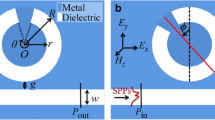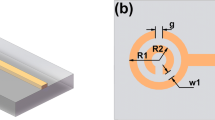Abstract
A plasmonic nanodevice in end-coupled sectorial-ring cavity waveguide is reported, and the spectral characteristic of the novel system is studied. It is built with sectorial-ring cavity resonator end-coupled to plasmonic waveguide, and this resonator is an oversize central angle (θ), alterable symmetry plane angle (ϕ), and fixed radius and gap, which has the advantages of forming split-ring-like, realizing asymmetrical cavity, and achieving spectral tunability and selectivity. The two-dimensional simulation indicates that the extra noninteger and traditional integer resonance modes are excited in the novel system, and the noninteger resonance modes are not achievable for the circular-ring cavity waveguide. It displays that these resonance modes of the novel system are drastically affected by changing the position of ϕ, which has different changes on maximum transmittances but is almost unchanged on resonance wavelengths. Importantly, the multiple resonance modes are highly sensitive to ϕ, and the proper modes are significantly enhanced, weakened, excited, or disappeared. It also displays that these resonance modes of the novel system are efficiently affected by changing the size of θ, which has similar and different influences on resonance wavelengths and maximum transmittances. This work shows that the method helps in designing accurately the transmission spectrum with prospective modes in nanophotonics, and the structure facilitates for realization of tunable and selective multichannel nanofilter or nanosensor in integration.






Similar content being viewed by others
References
Matsuzaki Y, Okamoto T, Haraguchi M, Fukui M, Nakagaki M (2008) Characteristics of gap plasmon waveguide with stub structures. Opt Express 16(21):16314–16325
Enoch S, Quidant R, Badenes G (2004) Optical sensing based on plasmon coupling in nanoparticle arrays. Opt Express 12(15):3422–3427
Maier SA, Kik PG, Atwater HA, Meltzer S, Harel E, Koel BE, Requicha AAG (2003) Local detection of electromagnetic energy transport below the diffraction limit in metal nanoparticle plasmon waveguides. Nat Mater 2(4):229–232
Sarid D, Challener W (2010) Modern introduction to surface plasmons. Cambridge Univ. Press, New York
Maier SA (2007) Plasmonics: fundamentals and applications. Springer, New York
Gan QQ, Gao YK, Wang Q, Zhu L, Bartoli F (2010) Surface plasmon waves generated by nanogrooves through spectral interference. Phys Rev B 81(8):085443
Tanaka K, Tanaka M, Sugiyama T (2005) Simulation of practical nanometric optical circuits based on surface plasmon polariton gap waveguides. Opt Express 13(1):256–266
Liu L, Han ZH, He SL (2005) Novel surface plasmon waveguide for high integration. Opt Express 13(17):6645–6650
Zhan SP, Kong DM, Cao GT, He ZH, Wang Y, Xu GJ, Li HJ (2013) Analogy of plasmon induced transparency in detuned U-resonators coupling to MDM plasmonic waveguide. Solid State Commun 174:50–54
Li BX, Li HJ, Zeng LL, Zhan SP, He ZH, Chen ZQ, Xu H (2016) Sensing application in Fano resonance with T-shape structure. J Lightwave Technol 34(14):3342–3347
Mei ZR, Zhao DM (2004) Propagation of Laguerre-Gaussian and elegant Laguerre-Gaussian beams in apertured fractional Hankel transform systems. J Opt Soc Am A 21(12):2375–2381
Veronis G, Fan SH (2008) Crosstalk between three-dimensional plasmonic slot waveguides. Opt Express 16(3):2129–2140
Zhan SP, Peng YY, He ZH, Li BX, Chen ZQ, Xu H, Li HJ (2016) Tunable nanoplasmonic sensor based on the asymmetric degree of Fano resonance in MDM waveguide. Sci Rep 6:22428
Zheng MF, Li HJ, Xu H, He ZH, Chen ZQ, Zhao MZ (2017) Filtering property based on ultra-wide stopband in double sector/sectorial-ring stub resonator coupled to plasmonic waveguide. IEEE Photonics J 9(5):2201308
Zheng MF, Li HJ, Chen ZQ, Xu H, Zhao MZ, Xiong CX (2018) Transmission performance based on plasmonic waveguide coupled with sectorial-ring stub resonator. IEEE Photon Technol Lett 30(5):415–418
Zhao MZ, Li HJ, He ZH, Chen ZQ, Xu H, Zheng MF (2017) Novel oscillator model with damping factor for plasmon induced transparency in waveguide systems. Sci Rep 7:10635
Lu H, Liu XM, Mao D, Wang LR, Gong YK (2010) Tunable band-pass plasmonic waveguide filters with nanodisk resonators. Opt Express 18(17):17922–17927
Zand I, Mahigir A, Pakizeh T, Abrishamian MS (2012) Selective-mode optical nanofilters based on plasmonic complementary split-ring resonators. Opt Express 20(7):7516–7525
Ma FS, Lee C (2013) Optical nanofilters based on meta-atom side-coupled plasmonics metal-insulator-metal waveguides. J Lightwave Technol 31(17):2876–2880
Setayesh A, Mirnaziry SR, Abrishamian MS (2011) Numerical investigation of a tunable band-pass plasmonic filter with a hollow-core ring resonator. J Opt 13(3):035004
Chen L, Liu YM, Yu ZY, Wu D, Ma R, Zhang Y, Ye H (2016) Numerical analysis of a near-infrared plasmonic refractive index sensor with high figure of merit based on a fillet cavity. Opt Express 24(9):9975–9983
Wang T-B, Wen X-W, Yin C-P, Wang H-Z (2009) The transmission characteristics of surface plasmon polaritons in ring resonator. Opt Express 17(26):24096–24101
Chen J, Li YD, Chen ZQ, Peng JY, Qian J, Xu JJ, Sun Q (2014) Tunable resonances in the plasmonic split-ring resonator. IEEE Photonics J 6(3):4800706
Wen KH, Hu YH, Chen L, Lei L, Guo Z (2014) Single/multiple-mode-selection optical nanofilters based on end-coupled split-ring resonators. Appl Opt 53(19):4158–4163
Wen KH, Hu YH, Chen L, Zhou JY, He M, Lei L, Meng ZM (2017) Tunable multimode plasmonic filter based on side-coupled ring-groove joint resonator. Plasmonics 12:427–431
Gong YK, Wang LR, Hu XH, Li XH, Liu XM (2009) Broad-bandgap and low-sidelobe surface Plasmon polariton reflector with Bragg-grating-based MIM waveguide. Opt Express 17(16):13727–13736
Palik ED (1985) Handbook of optical constants of solids. Academic, Boston
Haus HA (1992) Waves and fields in optoelectronics. Prentice-Hall, New Jersey
Bozhevolnyi SI, Jung J (2008) Scaling for gap plasmon based waveguides. Opt Express 16(4):2676–2684
Zheng MF, Li HJ, Chen ZQ, He ZH, Xu H, Zhao MZ (2017) Compact and multiple plasmonic nanofilter based on ultra-broad stopband in partitioned semicircle or semiring stub waveguide. Opt Commun 402:47–51
Zheng MF, Li HJ, Xu H, Zhao MZ, Xiong CX, Zhang BH (2019) Tunable and selective transmission based on multiple resonance modes in side-coupled sectorial-ring cavity waveguide. Plasmonics 14(2):397–405
Yu Z, Veronis G, Fan SH, Brongersma ML (2008) Gain-induced switching in metal-dielectric-metal plasmonic waveguides. Appl Phys Lett 92(4):041117
Zheng MF, Zhao MZ, Xiong CX, Xu H, Zhang BH, Xie WK, Li HJ (2019) Spectral characteristic based on sectorial-ring cavity resonator coupled to plasmonic waveguide. Appl Phys B Lasers Opt 125:53
Funding
This work was funded by the National Natural Science Foundation of China under Grant No. 61275174, and the Postgraduate Technology Innovation Project of Central South University under Grant No. 2017zzts062.
Author information
Authors and Affiliations
Corresponding authors
Additional information
Publisher’s Note
Springer Nature remains neutral with regard to jurisdictional claims in published maps and institutional affiliations.
Rights and permissions
About this article
Cite this article
Zheng, M., Xiong, C., Zhao, M. et al. Spectral Tunability and Selectivity Based on Multiple Resonance Modes in End-Coupled Sectorial-Ring Cavity Waveguide. Plasmonics 14, 1659–1668 (2019). https://doi.org/10.1007/s11468-019-00952-7
Received:
Accepted:
Published:
Issue Date:
DOI: https://doi.org/10.1007/s11468-019-00952-7




